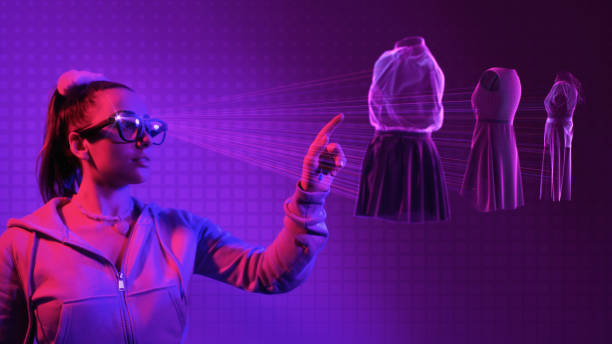The global pandemic has accelerated the adoption of digital products and services by as much as 6 years. In many instances, in order to protect their staff and their customers, digital has become the only medium brands could use to interact and transact with their customers.
This rapid digitization was reflected in many industries, from healthcare (I had my first video consultation with my family doctor), to financial services (with branches closed, banks saw an increase in online usage by 40-60%), education (students switched to online courses), to retail (shopping online from the convenience and safety of your home).
The last few years have also seen an acceleration of the adoption for XR solutions for the enterprise. All the digital dragons are investing billions to provide hardware and/or software solutions for web3 and the metaverse.
The reason is simple: metaverse represents a multi-trillion-dollar opportunity by the year 2030, and progressive companies have already started to invest in this space, and create assets and prototypes so they continue to build the right skillset in their organization, and also educate and adapt to feedback from the early adopters from their customer base.
Technology is a key differentiator, and some brands were born digitally native. Companies like Tesla or the Neo banks have disrupted their industries by thinking digital-first.
Retail, Commerce and XR

This is the first of a series of articles that will be looking at the dramatic impact that web3 and the metaverse will have on our civilization, and how it will disrupt and transform the various industries.
The first industry we will focus on is Retail, and we will discuss how XR and the metaverse will give shoppers multi-sensory and personalized experiences. We recognize that shopping / retail is huge space:
- It varies based on the goods sold, in fact, the US Census Bureau divides retail into the following 13 categories:
- Auto dealers
- Non-store, online, retailers
- Department stores
- Apparel
- Electronics and appliance stores
- Food and beverage stores
- Building and garden supply stores
- Sporting goods/hobby stores
- Health/beauty shops
- Furniture stores
- Hospitality and leisure
- Gas stations
- Miscellaneous
- There are also many types of buyers, which can be classified based on their motivators and desired outcomes. For example, we have browsers (not having anything in mind to buy when going into a store and are driven by curiosity, purposeful buyers (an intentional shopper who buys smart and what he needs), bargain hunters (someone who is looking for goods that are valued for money, usually because they are on sale at a lower price than normal), and loyal customers (looking for personalized brand interactions). Each category has different needs when shopping, and various retailers should be able to cater to those needs to attract more customers.
In this article, we will focus on the purposeful buyers, who are looking to maximize every moment (reduce time), minimize risk (no surprises / avoid returns) and make every dollar count (pay a fair price).
Since they have a specific goal in mind, they are unlikely to browse or look through items that are not on their shopping list. They will want to be able to eliminate the products / SKUs which do not match their needs (say filter by color, size, brand, dimensions etc.).
Let’s start by setting some context. Commerce is one of the oldest trades, involving transportation and exchange of physical goods. The digital revolution has introduced a number of changes.
Some goods are inherently digital, say watching movies on Netflix, or listening to music on Spotify. The business models have changed, with subscriptions becoming the preferred choice.
For example, Microsoft used to sell DVDs for Microsoft Office 2007 and Xbox games like Halo. Nowadays, Office is distributed as a monthly subscription to Office 365, and Xbox Game Pass comes with hundreds of high-quality games.
This became possible because money is now digital – we have a digital identity and a digital wallet, and it is convenient to access our money and accounts online for payments or money transfers. Which enables online payments and purchases.
Progressive organizations are building integrated and personalized omnichannel experiences, bringing the physical and the digital together, and giving their customers access to their products anytime, anywhere, on any device. A great example is Starbucks, and how they positioned their app to get, and access, all things Starbucks.
Digital means buying products online, on the online store of a particular brand, by using a marketplace like Amazon, or buying products using your phone, using the merchant’s mobile app, or by following an advert on Facebook or Instagram.
Micro-transactions can also take place without even leaving your current application — for example, in gaming, cosmetics and skins can be purchased right in Fortnite. Brands are also building richer and more engaging experiences online, product descriptions have moved from text, to visual imagery, to videos, to 3D assets.
The expansion of digital into the metaverse

Now digital has been expanded with a 3rd dimension, the metaverse. Hailed by some as the future of the Internet, and by others as a video game / Ready Player One experience, what is actually the metaverse, and why companies like Facebook have chosen to rebrand as Meta and spend billions to build the upcoming metaverse?
While there is no official definition I subscribe to, I envision the metaverse as a collection of persistent virtual worlds and augmented reality (which brings digital enhancements to physical worlds), typically multi-dimensional (3D, potentially enhanced with other type of sensory experiences, like touch, smell etc), and generally persistent, interactive, and social.
While these environments will provide the most engaging experience when accessed via specialized / multi-sensory devices for VR or AR, they will also work on other devices, like smartphones, tablets, glasses etc. Note that the concept of virtual worlds is not new, they have been built and used for years in video games, which are running on PCs, game consoles, and even phones.
A new world of opportunity

The 3rd dimension / world brings the opportunity of a new digital economy, a multi-faceted marketplace where one can build, buy, and sell digital goods. It starts by creating a digital identity, and your own 3D representation in the metaverse, in the form of digital avatars, which can also be customized with assets from brands like Prada.
Once immersed in this world, you can buy digital real estate — Decentraland’s sales were worth $110-million US, and in another virtual world, The Sandbox, they hit $350-million US.
If you’re hungry, you can drop by the virtual restaurants opened by McDonald’s or Wendy’s or Chipotle, featuring virtual goods, or you can order a real meal, which will be delivered to your door a bit later. If you’re looking for entertainment, go to an online actual or virtual concert.
Different devices have different characteristics, and thus they enable unique digital experiences. A smartphone is not just a miniature computer, which can render regularly on a smaller screen.
Instead, it has its unique benefits, from portability, to enabling special interactions like taking photos, cashing a cheque, texting, checking your calendar / emails, having video calls / FaceTime conversations, and so on.
Uniquely metaverse

Similarly, virtual reality, and the metaverse, has unique capabilities and benefits that can be used to craft immersive, multi sensory experiences, from 3D sound (you can whisper in the year of a nearby friend), to haptic feedback (not just for hands, but on your entire body, using body armor), to a full field of view, and even to smell.
So, the metaverse experiences will be multi sensory, and immersive. For example, a person will be able to try a product, say clothing or shoes, to ensure fit and styling.
One can have a full “virtual closet” with all the clothes in her wardrobe, and can use tools like AI to see various outfits and accessories, even a personal styling assistant to make recommendations for certain occasions, all while being aware of weather (hot / cold, precipitation forecast), the setting (indoor / outdoor), and transportation.
An example is the augmented shopping experiences to get a new pair of glasses. I often buy my glasses from my optometrist, and I quickly realize they have a limited selection and higher prices.
Compare that experience with Warby Parker’s app, for example, that has a quiz to help you define the right pair of glasses, then it allows you to virtually try on a few glasses by holding the phone to see a selfie and digitally overlaying a pair of 3D glasses over your face.
Similarly, Amazon Fashion has launched a Virtual Try-on Shoes AR app for your phone, which allows you to browse shoes online, and then visualize how they look on you using the AR app on your phone.
While a lot of the augmented shopping experience can happen from the comfort of the home, some buyers may choose showrooming to see an actual physical version of the product they want to buy, to try it hands-on before purchasing.
The augmented shopping experience can take place in the store, using things such as smart mirrors as H&M have recently launched, Sephora’s virtual makeup experience, or Burberry’s exclusive in-store augmented reality exhibit of the brand’s signature Olympia bag.
People searching for a physical product can get in-store directions to find the aisle where the product is located, then to get in-context information about the product, for example details about how a product was manufactured, especially for eco-friendly brands who want to show the quality material and manufacturing process.
Not every shopping experience can be made into a metaverse experience by simply digitizing the current experience. Instead, brands may need digitalization. For example, an immersive book-buying experience is not about seeing the physical book in 3D from different angles (we are not judging the book by its cover).
Instead, it could be more like a digital twin for a bookstore, giving users the feeling of social shopping in an actual bookstore, perhaps sitting at the bookstore coffee shop with their friends, while listening to relaxing music in the background. And instead of Amazon’s current “Look inside” the book, you can become “immersed” in the book scene and content — flipping pages can become an interactive, tactile, 3D experience.
Future development of AR and AI within the XR world will bring us to an even more immersive, contextualized experience. We can see the beginning of this now. For example, my phone calendar is connected to my car so that when I get in the car, it automatically puts the destination for my next appointment in the map app.
Or if I’m in downtown Toronto looking for a lawyer firm, the AR on my phone will show the lawyer companies in the area, ratings, if they have expertise in what I am looking for, say IP strategy, I can filter by price or company size. Or if I’m with my family and we are looking to eat, the app knows our food preferences and allergies and will highlight recommended restaurants for us.
Though the app is no longer in use, Google Now did recognize repeated actions that a user performs on the device (common locations, repeated calendar appointments, search queries, etc.) to display more relevant information to the user, providing a vision of what AI personal assistants can do.
Key takeaways
In this first blog post of the series, we provided some context about the metaverse trillion dollar opportunity, how it will disrupt various industries, and what progressive companies are already doing to innovate and create prototypes and initial concepts in the metaverse. We started with commerce, and in particular, picked one of the customer personas — purposeful buyer.
Our 3 main takeaways from this article are:
- The metaverse is happening and brands that act now will be best positioned to capitalize on the tremendous potential.
- The metaverse is a multi-trillion dollar opportunity, and represents the next stage in the evolution of the internet, which transforms the user experience from “browsing” 2D interfaces, to a multi-sensory and immersive 3D experience.
- A fully realized XR strategy will allow brands to deliver unprecedented customer experience and personalization.
Join us for the next installment in a couple of weeks, when we will highlight additional immersive experiences for commerce, spanning across other buyer profiles.





